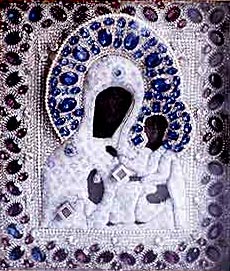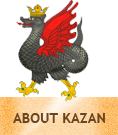The Cathedral of SS. Peter & Paul
Address: The Cathedral of SS. Peter and Paul
420011 Kazan city, M. Dzhalil str., 21
Tel.: (843)292-13-58

The Cathedral of SS. Peter and Paul of Kazan is undoubtedly the most valuable architectural monument and the one of the spiritual symbols of Kazan. It stands on a rising ground and attracts one’s attention with its magnificent majesty and peculiar decoration. The composition of the temple and its bell-tower performs so-called Russian or «naryshkin» baroque, which was widely spread over Russia at the end of the 17th – the beginning of the 18th century. The similar compositions can be found in the land of Kazan: the Pyatnitskaya (in the name of Great Martyr Parasceva of Iconium) church is in Kazan, and the church of Potanikha is in Vysokogorsky district of Tatarstan. It is significant that both churches were built by sponsorship of the merchant Mikhlyaev. The cathedral’ s decoration, and first of all the multitude of facade details as well as its bright coloration, well presented till now, makes it inimitable. Unfortunately, the names of builders who raised the cathedral are unknown. The majority of art experts point out that the cathedral’ s decorations are similar to the ones of the Ukrainian type, which were built in the Ukraine at the first half of the 18th century. It is quite possible that the Ukrainians built the cathedral, but the cathedral of SS. Peter and Paul is not a mechanical imitation of any other style. Most details of its appearance look quite unique and reach far beyond the limitation of any style.
 One more notable detail is the front staircase, which leads to the upper altar of the temple and faces the yard. Perhaps, the matter is that the modern layout of the streets of Kazan differed much from those when the cathedral had to be constructed. The modern street of Dzhalil did not arise yet, and from the opposite side there was a lane, which disappeared now. The Mikhlyaev’s house faced the front entrance of the cathedral and the side-chapels of the ground and of the first floor. At the end of the 18th century the regular layout was introduced. The architectural appearance of the cathedral was aptly supplemented with the fence that was built along Petropavlovsky lane (Dzhalil street now) by the project of Mikhail Korinfsky in 1850.
One more notable detail is the front staircase, which leads to the upper altar of the temple and faces the yard. Perhaps, the matter is that the modern layout of the streets of Kazan differed much from those when the cathedral had to be constructed. The modern street of Dzhalil did not arise yet, and from the opposite side there was a lane, which disappeared now. The Mikhlyaev’s house faced the front entrance of the cathedral and the side-chapels of the ground and of the first floor. At the end of the 18th century the regular layout was introduced. The architectural appearance of the cathedral was aptly supplemented with the fence that was built along Petropavlovsky lane (Dzhalil street now) by the project of Mikhail Korinfsky in 1850.The guests of Kazan were delighted with the cathedral, which was visited by all Russian emperors and empresses, beginning from Catherine II, by statesmen, public figures, writers, including Alexander Pushkin either. The cathedral was described in the works of Alexander Humboldt and Alexander Dumas. Meanwhile, the cathedral was a common parish church. The Cathedral of SS. Peter and Paul was known as early as since 1565. That time, at the same place, a small wooden church of SS. Peter and Paul was located. The biggest business undertaker of Kazan Ivan Mikhlyaev was a parishioner of that church. Nowadays, though considerably reconstructed, the Mikhlyaev’s house is still situated at the cathedral's yard. The emperor Peter the Great stayed at the Mikhlayevs within May 27-30, 1722, before he left for the Persian campaign. By the way, the empress Catherine II put up at the same house in 1768. In honor of that event Mikhlayev decided to replace the small church with a cathedral. The legend of the 19-20th centuries narrates Peter the Great's participation in laying of the foundation-stone of the cathedral, though it is not confirmed with any documents. The cathedral had been erected within a short period, as compared the other ones built that time. It was consecrated as early as in 1726. That year the bell-tower was constructed aside. Two years after, in 1728 Ivan Mikhlyaev, the benefactor of the cathedral, was buried in the special sepulcher beneath the bell-tower.
 |
The builders, the benefactor Ivan Mikhlyaev as well as the church wardens and the priesthood of past times have rendered the great service of creating and preserving the magnificent temple in Kazan although it was partially damaged many times. It suffered from the fire in 1742 and in 1749, during the Pugatchov’s riot in 1774, 1815 and 1842. The fire of 1815 damaged the cathedral very badly. That was why the parish was transferred to the church at Gostiny Dvor for 9 years. In 1824-1825 the churchwarden Savva Zaitsev, the merchant of Kazan and the grandfather of the outstanding chemistry scientist, sponsored the reconstruction of the cathedral. Since 1841, within almost a century the members of the merchants’ family the Unzhenins had been elected the churchwardens. From 1841 to 1850 Vasily Nikolayevich Unzhenin was elected the churchwarden. In 1860s, his cousin Vasily Stepanovich Unzhenin was a churchwarden, from 1870 to 1880 - the son of Vasily S.Unzhenin Pyotr V.Unzhenin was elected a churchwarden. The latter had to immigrate to China afterwards. Pyotr V.Unzhenin provided the sufficient amount of money to maintain the cathedral till 1929. By 1880s, mainly because of the base’s destruction, the cathedral considerably got ramshackled and the bell tower even started bending. The most parts of decoration lost its initial aspects. The churchwarden Pyotr Unzhenin and the rector of the cathedral Archpriest Pyotr Malov arranged a mass-scaled reconstruction of the cathedral. The restoration works were conducted by the project and under the guidance of a young architect Mikhail Litvinov who later on, at the end of the 19th and at the beginning of the 20th century, became the architect of the Cathedral of Christ the Savior in Moscow. Litvinov scrupulously restored the initial appearance of the cathedral with the help of drawings and detailed drafts compiled by the architect A.K.Shmidt in 1815.
 |
The main temple placed on the first floor was consecrated in honor of the most supreme Apostles SS. Peter and Paul. The temple provided with heating system is on the ground floor. It was consecrated in honor of the Meeting of Our Lord Jesus Christ in the Temple. Before the Revolution both the small side-chapels were consecrated in honor of the miracle-working icon of the Mother of God «Life-giving Spring» (the upper one), and in honor of the icon of the Mother of God «The Unburnt Bush». This day both the temples do not work. Under the Soviet authority the cathedral operated till 1939. The priest Andrey Bogolyubov had been servicing there since 1917 to 1930, until he was condemned to be prisoned for «anti-Soviet activity». The ground for that conviction was the money transfer made by the former churchwarden Vasily Unzhenin from China. After it was shut down, the cathedral was officially announced «the monument of architecture protected by the soviet government». It was available for excursion parties. From 1950 to 1980s a planetarium was arranged there. However, the cathedral was gradually about to lose its initial appearance. In 1989 the cathedral was returned back to the Church. Nowadays it is one of the most frequented churches of Kazan. Now the restoration works over the cathedral
Седмиозерная икона
Божьей Матери
are still in progress on a large scale. The cathedral retained the ancient seven-circled iconostasis with gorgeous ornamentation decorated accordingly to tradition of Russian baroque. This iconostasis was made within 1723-1726s, and after the fire of 1815 it was renovated by Vasily Turin the painter in 1824-1825. One of the most revered icons of local series is the icon of the most supreme Apostles SS. Peter and Paul.

 |
The miracle-working icon of the Mother of God of Smolensk and of Seven Lakes is one of the main sacred objects at the cathedral that was transferred from the church of the miracle-workers of Yaroslavl at the Arsky cemetery where it had been kept for a long time. This icon was saved by Hiero-Schema-monk Seraphim (Koshurin) after Seven Lakes Hermitage was closed in 1928. Another esteemed icon is the chrism fluent one of the Mother of God “Iveron” (in the lower temple). In the upper temple of the cathedral there is the reliquary of SS. Iona and Nektary, the sepulcher of the Zastolbskys, father and son, the former boyars, who took monastic vows and became the assistants to St. Gury. In the lower temple the relics of St. Efrem, the Metropolitan of Kasan, are rested. This hierarch crowned Mikhail Romanov in 1613. The relics of Bishop Arsenius of Jerusalem are also kept there. They were found in 1995 during archeological excavations from the demolished monastery of the Savior's Transfiguration on the territory of the Kremlin of Kazan under Zh. Alpheeva and A. Zhuravsky. At present, the restoration works at the lower temple of the cathedral are in progress. The new carved iconostasis have been set up, the walls have been decorated with fresco paintings. The Cathedral of SS. Peter and Paul is one of the main centres of spiritual life of the orthodox faithful in the land of Kazan.






The Cathedral Clergy
Archpriest Sergy Titov, senior priest; Hegumen Iulian (Epifanov), Archpriest Vladimir Mukhin, Fr. Oleg Demidkin, Protodeacon Alexander Spiridonov, Deacon Yevgeny Britvin, Deacon Valery Boitsov.
Service Schedule
The Divine services are performed every day:
-
8.00– Divine Liturgy
-
17.00 – Evening service
On Friday at 17.00 the Paraclesis Service to the Theotokos is conducted.
http://kazan.eparhia.ru/


